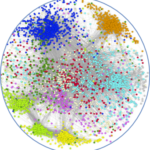Link to Pubmed [PMID] – 21084563
Link to DOI – 10.1242/jcs.066498
J Cell Sci 2010 Dec; 123(Pt 23): 4063-75
The organization of chromosomes is important for various biological processes and is involved in the formation of rearrangements often observed in cancer. In mammals, chromosomes are organized in territories that are radially positioned in the nucleus. However, it remains unclear whether chromosomes are organized relative to each other. Here, we examine the nuclear arrangement of 10 chromosomes in human epithelial cancer cells by three-dimensional FISH analysis. We show that their radial position correlates with the ratio of their gene density to chromosome size. We also observe that inter-homologue distances are generally larger than inter-heterologue distances. Using numerical simulations taking radial position constraints into account, we demonstrate that, for some chromosomes, radial position is enough to justify the inter-homologue distance, whereas for others additional constraints are involved. Among these constraints, we propose that nucleolar organizer regions participate in the internal positioning of the acrocentric chromosome HSA21, possibly through interactions with nucleoli. Maintaining distance between homologous chromosomes in human cells could participate in regulating genome stability and gene expression, both mechanisms that are key players in tumorigenesis.


